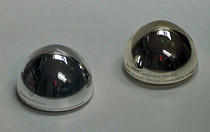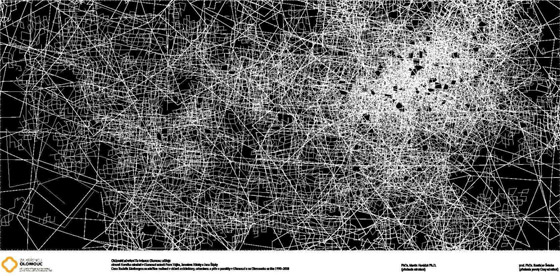
Transfer of the Rudolf Eitelberger Award for the years 1990–2008
 |
| The design and realization of the Rudolf Eitelberger Award was carried out by Jaroslav Koléšek. |
The civic association For a Beautiful Olomouc, in an effort to support, recognize, and commemorate quality achievements in the fields of architecture, urbanism, and heritage care in the region of its activity, awarded the Rudolf Eitelberger Award at the beginning of 2009, aimed at highlighting those interventions in the organism of historic Olomouc that positively and successfully influenced its changing appearance. This fulfills one of the goals of the Association, which is the promotion and informing of the public about construction and urban changes in Olomouc and its surroundings that affect the architectural, heritage, and urban values of the affected locations.
In the first, retrospectively conceived year, the commission consisting of members of the association and independent experts awarded this prize through secret voting to the revitalization of the Upper Square in Olomouc with the Aríón Fountain (1998–2002), thus recognizing Petr Hájek, Jaroslav Hlásek, Jan Šépka (HŠH architects) as the authors of the square reconstruction project, and Angela Chiantelli and Ivan Theimer as the main authors of the Aríón Fountain sculpture. The design by the HŠH architects studio defended its victory in the architectural competition mainly due to its sensitive and cultured solution of the square space with respect to its historical values. The requirement to preserve the historical context was also applied in supplementing the baroque complex of fountains with its last part - the Aríón Fountain, planned already in the mid-18th century, which was created by the Olomouc native, respected European sculptor Ivan Theimer, with the cooperation of Italian architect Angela Chiantelli from Lucca. In hindsight, it is necessary to designate the restitution of the Upper Square as exceptionally successful and sensitive to the historic core of the city. The architects respected the character of the given place; their timeless design did not bring a radical transformation of the appearance of the square and its material, layout, and urban solution. Leaving the pavement only strengthened the historical naturalness of this part of the city, providing it with undeniable aesthetic qualities that undoubtedly reflect in the social and tourist attractiveness of the place. This is further supported by the cultured information apparatus, including a model of the historical core of the city, and especially the attractive Aríón Fountain, which, with its "social magnetism," created a new and extraordinarily attractive social focal point in the city center. In the context of the transformations of Olomouc, as well as other Czech and Moravian cities after 1989, this realization belongs not only to the most distinct but undoubtedly to the highest quality. This is also evident in several awards that the project has received - a commendation at the Piranesi Prize in 2001 and an award in the reconstruction category at the Grand Prix of the Architects' Association in 2002.
With a certain time lag, filled with necessary coordination, the official presentation of the Rudolf Eitelberger Award to the architects - designers of the Upper Square reconstruction from the HŠH architects studio has been prepared. The award and the corresponding diploma will be presented in the presence of the representatives of the awarded
on Friday, September 11 at 11:00 AM at the café of the Archdiocesan Museum in Olomouc (Václavské náměstí 3)
The place of the award presentation was chosen symbolically, considering the fact that the reconstruction of the Archdiocesan Museum in Olomouc also originated from the HŠH architects studio.
The design and realization of the Rudolf Eitelberger Award were carried out by Jaroslav Koléšek (born 1974), who belongs to the significant Czech sculptors of the young generation. As a sculptor, he is versatile, working with stone, concrete, wood, plaster, glass, and plastic materials. He regularly exhibits at home and abroad (Poland, Germany). He is the author of the memorial to the aerial battle over Šanov and a holder of the Zlín Václav Chad Award (2003). He works as an assistant professor at the Department of Sculpture of the Faculty of Arts at the University of Ostrava.
www.vy3.net/k/fla.html
The design of the diploma for the Rudolf Eitelberger Award was created by Zbyněk Baladrán (born 1973), an artist, curator, and writer living and working in Prague. He studied art history at Charles University and visual arts at the Academy of Art. He regularly exhibits at home and abroad. In 2008 alone, he participated in exhibitions such as: “Atomized,” De Veemvloer, Amsterdam; “Finalists of J. Chalupecký Award,” Dům umění Brno; Gyumri Biennial, Gyumri, Armenia; “Try again, fail again, fail better,” Möcsarnok, Budapest; “Rendezvous nowhere,” Montehermoso, Vitoria-Gasteiz; “Where the East ends,” Nassauischer Kunstverein, Wiesbaden; “Be a Happy Worker: Work-to-Rule,” G-MK, Zagreb; “Another City,” Zacheta, Warsaw; “The Archive,” Prometeo gallery, Milan; “Same Democracy,” Neon>Campobase, Bologna. In recent years, he has been nominated several times for the prestigious Jindřich Chalupecký Award. He is one of the founders of the non-profit Gallery Display in Prague, which facilitates foreign contemporary art exhibitions and organizes exhibitions of Czech artists abroad. He is currently the president of the o.s. Display and is a member of the program board of the tranzitdisplay gallery, which is programmatically supported by Display. This year, he prepared, together with curator and theorist Vít Havránek, the project Monument of Transformation. www.tranzitdisplay.cz; www.monumenttotransformation.org
Regarding the diploma design - the rhizomatic map - Zbyněk Baladrán says: “It is a metaphorical map that illustrates the possibilities of linking structures, things, points, and lines, applicable to various fields of human knowledge. It is a representation of a non-hierarchical structure where individual points and areas are interconnected in certain relationships. They do not create primary and secondary lines from which others are derived, but lines that are equal to each other. Connections occur in unexpected contexts among themselves and across hierarchies. Thus, the map does not depict a specific situation; it is an abstract model for inspiration to perceive relationships in new constellations.”
 |
The English translation is powered by AI tool. Switch to Czech to view the original text source.
0 comments
add comment
Related articles
0
14.06.2023 | Rudolf Eitelberger Award 2023 - challenge from the association For Beautiful Olomouc
8
08.02.2009 | The Rudolf Eitelberger Award was won by the Restoration of the Upper Square with the Arion Fountain
1
07.01.2009 | Overview of the nominated buildings for the Rudolf Eitelberger Award
1
17.11.2008 | Rudolf Eitelberger Award for successful implementation in the field of architecture, urbanism, and care for monuments in Olomouc from 1990 to 2008
11
09.05.2008 | Civil Association for Beautiful Olomouc











